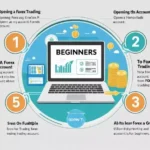Table of Contents
ToggleMaster the Forex for Beginners journey with SmartFXGuide — your trusted guide to smarter trading.
Forex, or the foreign exchange market, is the largest and most liquid financial market in the world. Every day, trillions of dollars are exchanged as individuals, institutions, and governments trade one currency for another. If you’re new to forex, this guide will walk you through the basics—so you can start your trading journey with confidence.
What is Forex?
Forex (short for “foreign exchange”) is the process of buying one currency while simultaneously selling another. This market operates 24 hours a day, five days a week, across major financial hubs like London, New York, Tokyo, and Sydney.
Unlike stock or commodities markets, forex trading takes place over-the-counter (OTC), which means transactions are done directly between parties—without a centralized exchange.
Why Trade Forex?
There are several reasons why forex has become a popular market for both beginners and experienced traders:
High Liquidity: With such a large daily volume, it’s easy to enter and exit trades quickly.
Low Barriers to Entry: You can start with a small amount of capital thanks to leverage.
Accessibility: The market is open 24/5, allowing for flexible trading hours.
Volatility: Constant price movement creates daily opportunities for profit.
Key Forex Terms You Should Know
Understanding some basic terminology will help you navigate the forex world more easily.
Currency Pair: Forex is traded in pairs like EUR/USD or USD/JPY. The first currency is the base; the second is the quote.
Pip: Short for “percentage in point,” this is the smallest price movement in a currency pair.
Spread: The difference between the buying (bid) and selling (ask) price of a currency.
Leverage: Allows you to control a larger position with a smaller amount of capital—but increases risk.
Lot Size: Refers to the number of units in a trade. A standard lot is 100,000 units.
What Affects Forex Prices?
Currency prices are influenced by a wide range of economic and geopolitical factors, such as:
Interest Rates: Central bank policies can strengthen or weaken a currency.
Economic Data: Reports like GDP, unemployment rates, and inflation impact trader sentiment.
Political Events: Elections, conflicts, and trade agreements can all shift the market.
Market Sentiment: Bullish or bearish trends often reflect how traders feel about a country’s economic outlook.
Types of Forex Traders
There are several approaches to trading forex depending on your goals and personality:
Scalpers: Make dozens of trades daily, aiming for small profits.
Day Traders: Enter and exit trades within the same day.
Swing Traders: Hold trades for several days to capture larger market moves.
Position Traders: Hold trades for weeks or months, based on long-term trends.
Bull and Bear Markets in Forex
A bullish market means traders expect a currency to rise in value.
A bearish market means traders anticipate a currency will fall.
Recognizing these trends can help you decide whether to go long (buy) or short (sell).
Volatility and Liquidity
Volatility refers to the price fluctuation of currency pairs. High volatility means bigger movements—both risks and opportunities.
Liquidity measures how easily a currency can be bought or sold. Major pairs like EUR/USD are the most liquid and often best for beginners.
Conclusion: Start Your Forex Journey the Smart Way
Learning how forex works is the first step toward becoming a confident and strategic trader. At SmartFXGuide, we’re here to help you build your skills, avoid common pitfalls, and develop a trading style that fits your goals.
Explore our beginner-friendly resources, test your strategies with a demo account, and start trading forex with clarity and control.
👉 Ready to dive in? Visit our full guide at smartfxguide.com/forex-for-beginners



